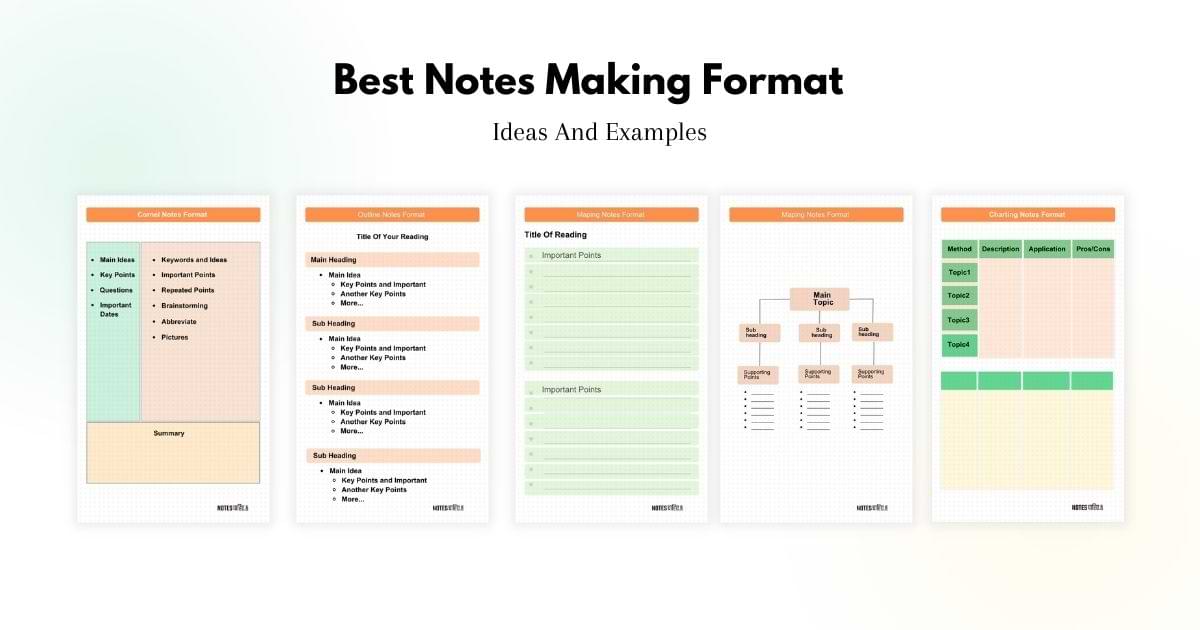Every student from board Class 10, Class 11 Bio Science and Commerce to a College , every one want to learn about Notes Making Format. Most are searching for Ideas and Examples.
We noteschahiye.com is the student community platform for helping the Notes Problem. In the following content, we have elaborated the Notes Taking Techniques through examples and ideas for class 11 science and commerce.
What Is Notes Making In 2023
In 2023, you can concise the information with the use of ChatGPT-like AI. Do you really need to learn about Notes Making?
Yes. Research says HandWritten Notes help to learn and remember the concepts and topics. Therefore you should learn note-taking techniques.
Note-making, also known as note-taking, is the practice of recording or writing important information while studying or taking lectures.
It helps students capture the essence of the points, so they don’t have to rely on memory alone.
Note-making isn't just about jotting down everything you read or hear; it's also about organizing and summarizing ideas.
Effective Note-Making Involves Two Key Processes:
- Capture Information:
Only take notes of valuable information for future use, as we cannot rely solely on memory. This step is crucial for retaining knowledge obtained through reading, speaking, or listening, even if it’s not immediately applicable. - Organize for Retrieval:
Ensure that your notes are well-structured and organized to facilitate easy access and utilization of stored information. Careful organization enhances the practicality of your notes.
Benefits Of Notes Making In 2023 For Students
The note making process can provide you with different benefits which will help you in memorization, effective learning, time management and exam readiness.
| Benefits of Note-Making | Description |
|---|---|
| Academic Success | Helps in succeeding in studies |
| Effective Learning | Promotes active engagement with materials |
| Better Retention | Aids in remembering and retaining information |
| Accessibility of Information | Provides a handy reference for review |
| Enhanced Understanding | Encourages deeper comprehension |
| Efficient Review | Facilitates faster and more efficient review |
| Improved Critical Thinking | Encourages critical thinking about the content |
| Active Participation | Keeps students engaged during lectures |
| Customization | Adaptable to individual learning preferences |
| Time Management | Helps in managing study time efficiently |
| Reduced Anxiety | Alleviates anxiety about forgetting |
| Long-Term Knowledge | Valuable resource for future courses and career |
| Exam Preparation | Valuable study tool for exam preparation |
| Reference for Assignments | A source of information for assignments |
| Improved Study Habits | Encourages good study habits |
| Active Participation in Class | Promotes participation in class discussions |
| Confidence Boost | Builds confidence in knowledge and abilities |
| Lifelong Skill | A skill useful beyond school |
Best Notes Making Format Ideas 2023
| Notes Format | Description |
|---|---|
| The Outlining Method | Organizing notes in a structured outline format. |
| The Mapping Method | Creating visual maps or diagrams to represent ideas. |
| The Sentence Method | Writing down key points and concepts in sentences. |
| The Cornell Method | Dividing the page into sections for notes, cues, and summaries. |
| The Charting Method | Using tables or charts to organize information. |
1. Outlining Notes Format:
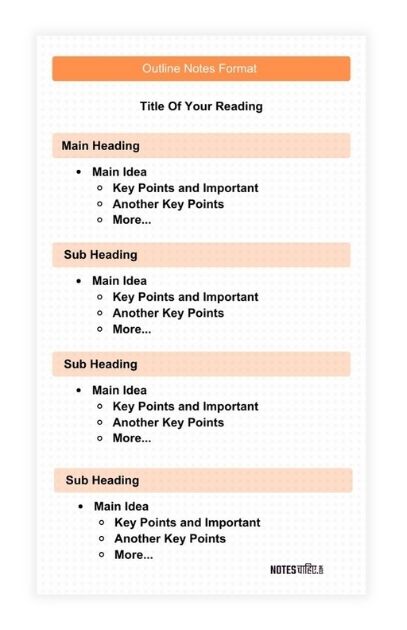
- This method involves creating a structured outline of your notes.
- You organize information hierarchically, with main topics at the top and subtopics below.
- It’s like creating a list of headings and subheadings to represent the content’s structure.
- Helps you see the relationships between different ideas.
2. Mapping Notes Format:
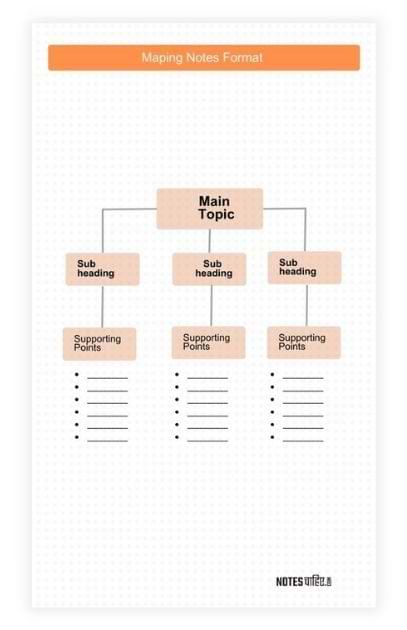
- Mapping uses visual diagrams or mind maps to capture and connect ideas.
- You start with a central concept or topic and branch out with related points.
- Arrows and lines show how ideas are linked, making it easier to understand complex concepts.
- Great for visual learners and brainstorming.
3. Sentence Notes Format:
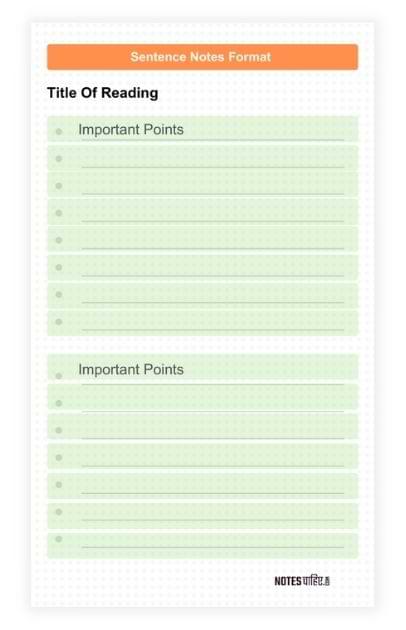
- With this method, you write down notes using full sentences.
- It’s more detailed than other methods and often used in academic settings.
- Helps in capturing complete thoughts and explanations.
- Can be time-consuming but provides thorough notes.
4. Cornell Notes Format:
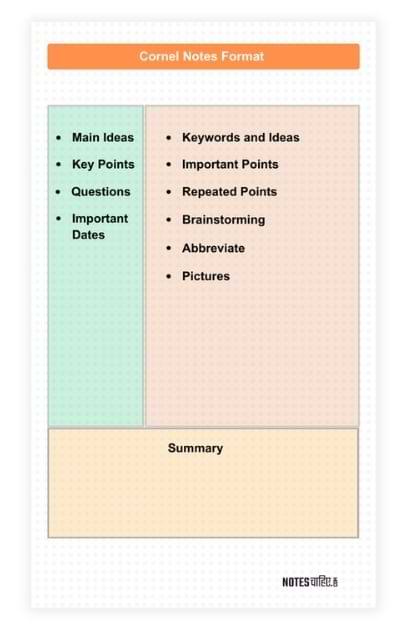
- The Cornell method divides your note paper into three sections: notes, cues, and a summary.
- During a lecture or while reading, take notes in the largest section.
- Afterward, add cues or questions in a narrow column on the left.
- Summarize the main points in a section at the bottom.
- It encourages active learning and easy review.
5. Charting Notes Format:
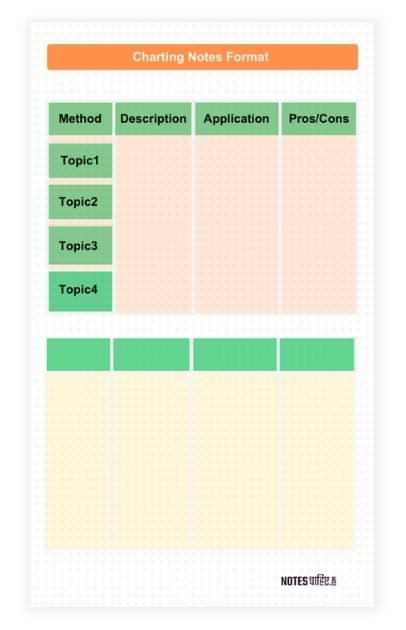
- This method uses tables, charts, or columns to organize information.
- You create rows and columns to categorize details.
- Suitable for data-heavy subjects, comparisons, or organizing data sets.
- Provides a clear visual structure for your notes.
Key Points While Using Notes Making Format In Study
Here are the points to remember for note-making in a more concise form:
- Avoid long headings.
- Retain the main idea.
- Ignore less important information.
- Be brief, clear, and specific.
- Use logical sequencing.
- Give notes a meaningful title with proper indentation.
- Focus on key examples.
- Presentation matters.
- Avoid extra spaces for clarity.
- Avoid personal interpretations.
- Include at least four abbreviations with full stops.
- Enhance notes with colours, drawings, and symbols for memorability.
A Example of Note Making and Summarizing Class 11
Example 1: Read the passage and make format and summarize it with title
You may never want to fly kites to keep away evil spirits, as the Chinese have done for centuries, or to make rain, as the Tibetans did, but some more modern and western uses may tempt you to try experimenting yourself along similar lines. Ancient and medieval Chinese sources describe kites being used for measuring distances, testing the wind, lifting men, signalling and communication for military operations.
The earliest known Chinese kites were flat (not bowed) and often rectangular. Later, tailless kites incorporated a stabilising bowline. Kites were decorated with mythological motifs and legendary figures; some were fitted with strings and whistles to make musical sounds while flying. From China, kites were introduced to Cambodia, India, Japan, Korea and the western world.
The most widespread use of kites in modern times has been for meteorological investigations. Everybody knows about how Benjamin Franklin, the great American scholar and statesman, sent a kite up in 1752 during a thunderstorm to prove that lightning was caused by electricity. He produced sparks at ground level from a key hung on the wet line as the current flowed down it.
A second investigator repeated Franklin’s experiment shortly afterwards and was killed. By sending up instruments on kites it has been possible to make readings of air pressure, temperature, speed, direction and humidity. Although thermometers had been sent up long before, it was not until 1894, that a self-reading thermometer, a thermograph, was sent up by a kite.
(a) One the basis of your reading of the above passage, make notes on it using headings and subheadings. Use recognizable abbreviations (minimum four) and a format you consider suitable. Supply a suitable title to it. (5)
(b) Make a summary of the above passage in about 80 words. (3)
Answer of the example
Title: Kite Use in History and Modern Times
I. Ancient Uses of Kites
- Chinese & Tibetan traditions
- Purposes: ward off evil spirits, make rain, military operations
- Early Chinese kites: flat, rectangular
- Tailless kites with stabilizing bowline
- Decoration with mythological motifs
- Musical kites with strings and whistles
II. Spread of Kite Usage
- Introduction to Cambodia, India, Japan, Korea, and the West
III. Modern Meteorological Use
- Benjamin Franklin’s lightning experiment (1752)
- Instruments on kites for air measurements
- Key developments: self-reading thermometer in 1894
Summary:
Kites have a rich history, from ancient Chinese and Tibetan traditions, where they were used for various purposes, to their introduction in Cambodia, India, Japan, Korea, and the Western world. In modern times, kites found significant utility in meteorological investigations, famously demonstrated by Benjamin Franklin’s lightning experiment in 1752. By sending instruments aloft on kites, measurements of air pressure, temperature, speed, direction, and humidity became possible, with key advancements like the self-reading thermometer introduced in 1894.
FAQs Notes Making Format
In note-making, headings convey the main purpose, and subheadings organize the topic. Multiple subheadings can be used for better organization.
Sub-subheadings are used to further categorize or detail aspects like categories, types, advantages, and more below the main points. They help create a hierarchical structure for your notes.
>Read the passage.
>Highlight important sentences for headings and subheadings.
>Make a rough note to understand the main idea.
>Organize the notes logically.
>Follow the proper note-making format.
>Keep the passage’s original idea intact.

